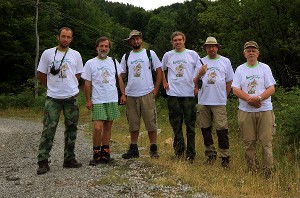Endangered Serbian Butterflies – Urgent Need for Research and Conservation
This page is dedicated to the project on research and protection of endangered butterflies of Serbia. The project is lead by Miloš Popović, and financially supported by The Rufford Small Grants Foundation. See the bottom of the page for complete list of people and organizations contributing to the project.

 Babin Zub, strictly protected area on Stara Planina Mt.
Babin Zub, strictly protected area on Stara Planina Mt.Basic project ideas and goals
Serbia is a country of reach, yet not well explored biodiversity, with total of 194 butterflies species. In many places mosaic habitats and traditional agriculture were ensuring stable butterfly populations over the years, but development of modern agriculture, tourism and industry on one side, and depopulation on the other had a great impact on these species. At the same time, lack of scientific data affects planning and management of the protected areas, which often neglect butterfly diversity. As a consequence protected high mountain bogs on Stara Planina Mt. are being turned into hotels, habitats of Bog Fritillary (Boloria eunomia) are being destroyed.
 Boloria eunomia, highly endangered by ski tourism on Stara Planina Mt.
Boloria eunomia, highly endangered by ski tourism on Stara Planina Mt.This project is mainly focused on scientific and educational activities, as a first step in conserving valuable butterfly species in Serbia. Most activities will be organised as a field surveys in order to get the precise picture of the distribution of Boloria eunomia and endangered species from Red Data Book of Serbian Butterflies and European Habitats Directive and to locate new important areas for butterfly conservation. During these activities a lot of effort will be made to involve and train young entomologists for their own projects and research and to establish a network of people and NGOs involved in protection of butterfly species.
 Nymphalis vaualbum, one of the highest conservation priority species in Europe
Nymphalis vaualbum, one of the highest conservation priority species in EuropeAll the results will be entered into butterfly species database and published as scientific papers. The relevant government institutions and general public will be informed of project results and aims through e-mails, letters, brochures, t-shirts, info boards, Internet, TV, newspapers, etc. This will made a sound foundation for future conservation of butterflies and a base for publishing significant books such as Atlas of Serbian Butterflies and Serbian Butterfly Field Guide.
Some work is already under way to publish field-guide and establish connections with NGOs and Serbian entomologists. The ultimate goal will be achieved if government involve project results in future planning of protected areas and construction sites.
Recent news and activities
The first spring field trips!
The first field surveys have started in March. Probably the most interesting finding was new locality for Nymphalis vaualbum near Gornja vrežina village, close to Niš city.
Some of us were visiting many new localities in eastern Serbia in order to plan key sites for future reserach. Central event was an unplanned meeting of most of our crew with Tamas Hapka from Hungary. This took place in Temska village on Stara planina Mt. and during the meeting we had a lot of topics to discuss. A couple of cloudy days were used to explore some areas rich in ammonite and shell fossils. We own great thanks to DZPPS that was our host during field surveys in Negotin region.










T-Shirt design is completed

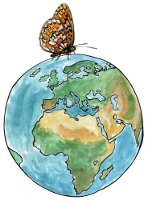
Ovčar-Kablar gorge camp

 Ovčar-Kablar gorge from the top of the Kablar hill
Ovčar-Kablar gorge from the top of the Kablar hillA big biological camp was organized in Ovčar-Kablar gorge at the end of April, with financial supporf of tourist organization of Čačak. Serbian legislature awarded this gorge first category protection. We would like to thank the tourist organisation for organizing camp and helping us in field research. The goal of this year's camp was entomological survey with special regard to fauna species included in Natura 2000. During April camp we found a few new species of butterflies and moths for the region, and a new species of lizard (Ablepharus kitaibeli), but further research is planned for this year.
Spring field gathering on Stol Mt.
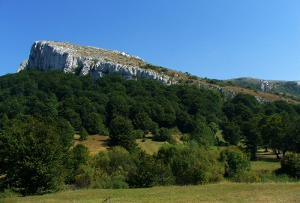 Calcareous mountain massifs on Stol
Calcareous mountain massifs on StolAn outing to Stol Mt. near town of Bor was organised in period May 20-22. That is calcareous massif reaching 1155 meters of altitude, with insufficiently researched flora and fauna. The mountain was chosen to be Prime Butterfly Area (PBA), certainly due to several entomological surveys by Momčilo Zečević performed in the second half of 20th century.
Research team was made of 17 people, members of HabiProt and BDDSP, mostly from Niš, Novi Sad and Belgrade. It was an honour to have present a group of Dutch nature lovers, guided by Milan Đurić. The outing also was an opportunity to exchange experiences and plan future fieldwork and promotional activities.













Field survey in southern Serbia and a new species
 Antocharis gruneri habitat
Antocharis gruneri habitat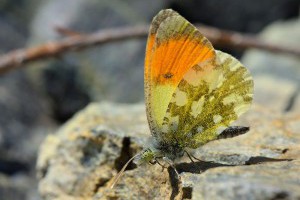 Antocharis gruneri
Antocharis gruneriBy mid-May we organized a field survey with our frinds from NGO (DZPPV) and from Bulgarian NGO (Zeleni Balkani) in southern parts of Serbia. The most interesting area was Miratovac village, where strong submediteranian influence coming through Preševo valey is felt. We were happy to find a new species for butterfly fauna of Serbia, Gruneri’s Orange Tip (Antocharis gruneri). As this habitat is unique for Serbia and presents a very important area for herpetofauna and ornitofauna, it should be included in future protection plans. At the same time, this is a new potential Prime Butterfly Area for Serbia.
We are proudly wearing our new T-Shirts!!! :)
The final design of our Shirts is created by Aleksandar Popović (drawings), Ivan Milovanović (design) and Karatina Ristić (design).


Field studies and workshops on Goč Mt.
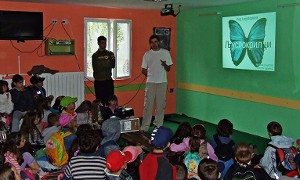
In cooperation with Kraljevo academic society "Balkan", we organized scientific expeditions and workshops for the public school children. The children had a chance to learn many less known facts about the interesting world of biology, and we were rewarded by the level of enthusiasm the children showed. We would like to thank the managers of the children resort for providing us accommodation.















Field surveys on Stara Planina Mt. and another new species for Serbia
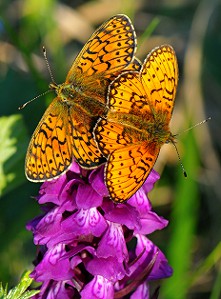 Mating couple of Boloria eunomia
Mating couple of Boloria eunomiaDuring June and July a few expeditions targeted Stara Planina. The main aim of our expeditions was to check known populations of the Bog Fritillary (Boloria eunomia) and to search for the new colonies. One of two known populations on Babin Zub had been completely destroyed at the beginning of construction works on the ski resort. The second population can be marked as stable, but this area is also planned for construction site. The third population was found on Jabučko ravnište, but is highly endangered by the building of a big hotel and capturing of the water flowing through the bog.
Besides checking these known populations, attempts were made to find new ones on few occasions. Unfortunately, no new colonies of the Bog Fritillary were found, and that only amplifies the importance of conservaing those that remained. The most interesting potential locality proved to be Ponor, near the Dojkinci village, with some parts very similar in geology and vegetation to the ones near Babin zub. Basic criteria in choosing research areas were geological factors, presence of the larval host plant (Polygonum bistorta) and a satellite images from Google Earth.
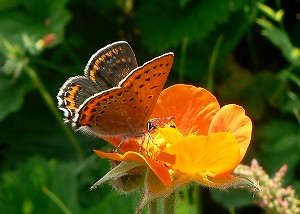 Lycaena helle, a new species for Balcan peninsula
Lycaena helle, a new species for Balcan peninsulaAlthough we could not find new populations of the Bog Fritillary, we were overwhelmed to discover a population of Lycaena helle, a species never recorded on the Balkan peninsula. This species is a boreal relict considered endangered in Europe. As the population encountered is very small, protection of this species in Serbia should be given high priority, and species should be included in the List of strictly protected species. We will do everything we can to inform on this valuable finding and to seek adequate protection of this small habitat which this species inhabited for thousands of years.
During the field surveys, many more interesting species were found, such as mountain ringlets (Erebia ottomana, E. alberganus, E. orientalis...) and some of the rare European butterflies, such as Nymphalis vaualbum, Kirinia climene, Melitaea arduinna... All the data gathered in the field were entered into HabiProt database.



















Scientific expedition „Stara Planina 2011“
 Stara Planina Mt., Zavoj lake
Stara Planina Mt., Zavoj lakeFrom July 1 to July 20, we participated in Fourth scientific camp in Temska village, organized by many NGOs gathered on biodiversity protection, as well as the local citizens and Temska community. The results will be published as a monography on the Temska village. Besides numerous scientific activities, many volunteers were busy removing invasive Alianthus tree and organizing a small artistic colony. Temska comunity organized Food festival, where everybody had a chance to try traditional kitchen of eastern Serbia. Several workshops were organized: on biodiversity protection on Stara Planina, on eco- and ethno- tourism development. Throughout these 20 days of camp the local population had a chance to learn something about endangered species and activities needed to preserve this valuable diversity.
In short: Magical mix of culture, entertainment, science and nature protection!
Serbian butterfly Fieldguide
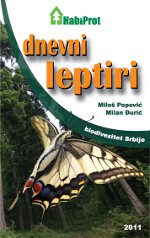 Field Guide
Field GuideFor several months we were discussing possibilities to publish Serbian Butterfly Fieldguide, and throughout the winter we were preparing draft of that book. Now we can proudly say that the Fieldguide is completed and ready for printing. At the beginning everything was put as "temporary", but after eight months of effort, many sleepless nights, arguments, picture replacements and text corrections we are convinced this book took its final shape.
With this fieldguide we target beginners, so the complete book was written in simple, non-scientific language. We involved as many Serbian photographers as we could and some foreigners that visited Serbia, so 27 photographers contributed. Some beginners gave us a lot of useful suggestions after testing electronic beta-version of the book in butterfly determination.
It should be emphasized that Rufford Foundation helped us by financing field surveys. They presented superb opportunity to gather many great photos for the fieldguide. Embassy of the Netherlands (MATRA-KNIP programme) and the city of Belgrade (Secretariat for nature protection) financed book printing and promotion. We would like to thank all the sponsors and persons that helped us publish the first butterfly fieldguide in Serbian ever.
You can fing out more about this book, and how to buy it here.
Small camp on Povlen Mt.
From July 21 to 23, our entomological group joined Milan Đurić and a couple of Dutch entomologists (Kars Veling and Bernard Kranenbarg). We were exploring southern slopes of Povlen, Maljen and Mučanj Mts. In just a few days we recorded many rare butterfly species. Tho most interesting was a huge population of Phengaris alcon on Divčibare, and a confirmation that a small Apollo (Parnassius apollo) population still exists on Povlen Mt. Evenings were used to exchange experiences in butterfly conservation with people that are many steps in front of us in this area.













Stolovi and Čemerno Mts.
During August, our friends from KAPD „Balkan“ were more than happy to show us some of the most beautiful terrains surrounding Kraljevo City. Stolovi, Gledićka planine & Čemerno Mts. are not well researched in terms of butterfly fauna, although some of this mountain areas are included in Serbian Prime Butterfly Areas. We hope that this kind of expeditions would be a good start for further research activities and finally for the protection of the most beautiful butterfly habitats.







Infoboards
The design for the infoboards to be put on Stara Planine Mt. is complete. I would like to thank my friend Katarina Ristić for preparing the complete design, to the authors of the photos and to everyone that helped in preparing the text.
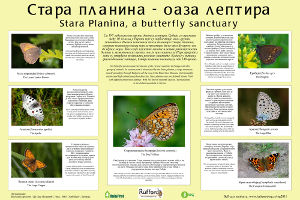
...and much more!
And the whole story does not end here! Aside the mentioned field trips, we have visited many of other localities in Serbia, sometimes only for one day field trips. There were many interesting findings too! After couple of decades we finally rediscovered Black Ringlet (Erebia melas) and Small Pearl-bordered Fritillary (Boloria selene) in Serbia, on the places where they were never recorded before. Also, very interesting finding is Persian Skipper (Spialia phlomidis), first record in Serbia outside Kosovo region.
 Persian Skipper (Spialia phlomidis)
Persian Skipper (Spialia phlomidis)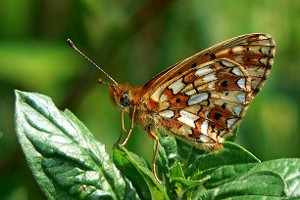 Small Pearl-bordered Fritillary (Boloria selene)
Small Pearl-bordered Fritillary (Boloria selene)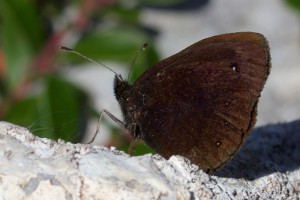 Black Ringlet (Erebia melas)
Black Ringlet (Erebia melas)During field surveys on butterflies, we found one new moth Serbian fauna. It is the species Hemaris croatica, from the Hawkmoth (Sphingidae) family. Edit: Hemaris croatica have already been recorded in Serbian fauna, close to Ibar gorge, making this finding the second one for Serbia. The fauna of Longhorn beetles is now richer for another species (Blepisanis vittipennis), and after many years Bradyporus dasypus grasshopper was found in Serbia.
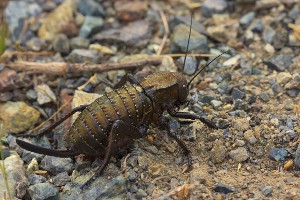 Bradyporus dasypus
Bradyporus dasypus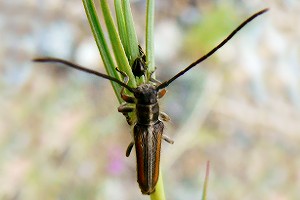 Blepisanis vittipennis
Blepisanis vittipennis Hemaris croatica
Hemaris croaticaPromotion and popularisation
Infoboards on Stara planina Mt.

Our host, Dule Mihajlović from Temska village has prepared construction for the infoboards while the local people helped us to put them on the ground. One of the boards in in the village itself, while the others are on Vidlič and Babin zub. Many thanks to the people from of Temska that helped us during tree years of field studies!!!




Mailing list and Forum

Since this project started the number of our mailing list members was growing, finally reaching 50!!! The basic idea for the list was research and protection of butterflies, but it has grown much wider, gathering a large community of entomologists with very different fields of interest. The members range from PhDs to beginners in the world of six legged creatures. If you would like to join the list, please send us a request here.
Beside mailing list, recently a forum was started at this address in order to gather more biologists interested in making a database on Serbia biodiversity. The forum is closed type, so to get registered you need to contact admins (Miloš — ![milos[na]habiprot[tacka]org[tacka]rs](images/milos.gif) or Gabor —
or Gabor — ![gabor[na]protego-org[tacka]org](images/gabor.gif) ). This forum is a result of cooperation with Research centre „Petnica“ and NGO Protego.
). This forum is a result of cooperation with Research centre „Petnica“ and NGO Protego.
Facebook group

Now you can folow us on Facebook! Join our group and share some interesting facts from the insect world! The group should be a nice place for casual talks and a place where you could be informed about our recent activities.
News and magazines
During the project we have worked on popularization ant promotion of butterflies in magazines and newspapers. You can read some of the texts here:
- Politika July 3 - Flight in two (author: Filip Franeta)
- Evening News, december 14. - Photosafari for a winged pearls
- IUCN South-Eastern European e-Bulletin No. 28
Butterflies on television
...and we were on a couple of TV stations:
- Niš TV - Ekooasis, 10.11.2011.
- Ljig TV - end of October
- Timoka TV - Rezime 23.11.2011.
- FIRA - Info Press 24.11.2011.
- TV Bor
- RTV Stara Pazova
Promotion of the Serbian Butterflies Fieldguide
Promotions were/will be held in these places:
- Niš, Faculty of Natural Sciences and Mathematics, 7.10.2011.
- Belgrade, City council - Nikole Pašića 6, 28.10.2011.
- Belgrade, Book faire, 23-30.10.2011.
- Kraljevo, Public library „Stefan Prvovenčani
- Kragujevac, Faculty of Natural Sciences and Mathematics"
- Zaječar Radul Beg konak, 23.11.2011.
- Zrenjanin, Public museum, 24.11.2011.
- Subotica, NGO Riparia, 25.2.2012.
- Vršac, NGO Gea, 1.3.2012.
- Novi Sad, Institute for Nature Protection, 6.3.2012.






Miscelaneous...
...in the meantime, we were here:
- Teaching on biodiversity and promotion of butterfly conservation, Niš 23.10.2011. You can check out the photos here.




Brochures
You can download brochures of Serbia:
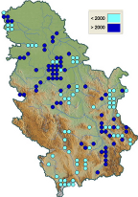
Serbian insect database is growing!
More than 6,500 records were entered into butterfly database in 2011. That is more than long-term average and more data that were gathered from all literature sources. It helped a lot in getting more acurate picture both on distribution and period of the year when imagoes are flying. Some new enthusiasts joined national recording scheme, and with field guide available, we expect that trend to improve.
Much was done to start similar scheme for insects other than butterflies and moths. The database now covers more than 3,300 insect species.
Scientific reports
Boloria eunomia and Lycaena helle acessment
The report on the status of this two rare and endangered butterflies was sent to all Government institutions. The current state is alarming as the species habitats are marked for building of hotels and ski tracks, and will be destroided along with the high mountain springs and marches. We got positive oppinion only from „Srbijašume“, Serbian forestry company in charge for protection of the Natural Park „Stara Planina“, and there hope that the our effort will not be wasted.
You can find the complete report on this link (in Serbian).
Scientific publications
Follow this page to be informed on new scientific publications made during the project! The publications will be listet as the papers come out of printing.
- Đurđević, A., & Đurić, M. (2011): Blepisanis vittipennis (Reiche 1877) (Coleoptera: Cerambycidae), a new longhorn beetle for Serbia. Biologica Nyssana, Journal of Biological Sciences, 2 (2)
- Popović, M., & Milenković, M. (2012): First record of Anthocharis gruneri for Serbia (Lepidoptera: Pieridae). Phegea 40(1b): 37-38.
- Ralev, A., Popović, M., Ružić, M., Shurulinkov, P., Daskalova, G., Spasov, L. & Crnobrnja-Isailović, J. (2013): A new record of Testudo graeca ibera Pallas, 1814, in southern Serbia. Herpetozoa: 25(3/4): 151-153.
- Nikolić, J., Đurđević, A., Popović, M. (2013): Butterfly fauna of Ženeva pond near Niška Banja spa center (Lepidoptera: Papilionideae & Hesperioideae) with some notes on endangered species. Biologica Nyssana 3(2): 47-51.
- Popović M, Đurić M, Franeta F, Van Deijk JR, Vermeer R (2013): First records of Lycaena helle butterfly for the Balkan peninsula (Lepidoptera: Lycaenidae). SHILAP Revta. Lepid. 41(163). [proof]
Behind the curtain
Funny cook

This project year was a great success. We can easily say that we did twice more than we planned, if for no other reason than for Butterfly Fieldguide. Also, we accomplished much more surveys than planned, and that probably would not be possible without our cook - Đuki (Aca Đurđević) :) His responsibilty was that we always have delicious meals from cauldron, always made as cheap as possible. Fresh beans, the wispering sound of fire in front of our tents and a warm summer night will all be remembered forever!
Disobedient cars

Motor pool of the project consisted of one red Yugo and a „Gonepteryx“ (yellow model 101, more than 20 years old), both made in Serbia by manufacturer Zastava. They served their purpose, so we managed to reach any place we wanted, but, on the other hand, it is difficult to remember a single field trip without some breakdown. If not for our emotional bond with those bangers, we would probably have all the rights to be annoyed. However, solutions seemed always to come out of nowhere, with some incredible improvisations and without our desperation. Such eventful season eventually turned us into decent mechanics! :)
People and organisations involved in the project
The main team leading the project: |
Involved NGOs: |
Miloš Popović Filip Franeta Aca Đurđević Ivan Simonović Sandra Cvetković Ivan Milovanović |

ХабиПрот, Београд

Биолошко друштво „Др Сава Петровић“, Ниш |
We would like to express our honest gratitude to Dr. Rudi Verovnik, Dr Jelka Crnobrnja-Isailović, Milan Đurić, Milan Ružić and Goran Nikolić for their kind support that made this whole project possible.


